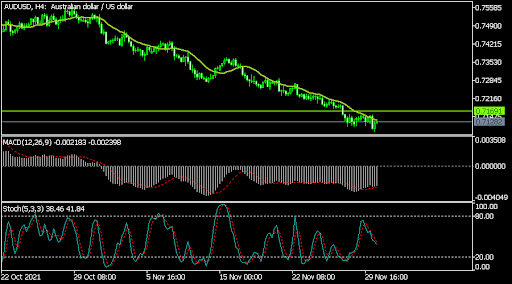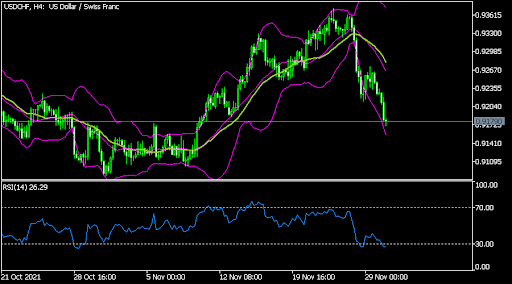Global stocks retreated sharply on Tuesday as concerns about the new variant of the coronavirus rose. In the United States, futures linked to the Dow Jones index declined by more than 1.1% while those linked to the Nasdaq 100 index declined by more than 1.5%. It was also a sea of red in Europe, where indices like the German DAX and FTSE 100 declined by more than 1%. This drop happened after the Chief Executive at Moderna warned that existing vaccines will struggle with the current variant. He also said that it will take months for companies to come up with a jab specific for this vaccine. There are also additional concerns about future variants of the disease. Some of the worst-performing stocks were those in the hospitality industry.
The euro rose against the US dollar and the British pound after the strong Eurozone inflation numbers. Data published by Eurostat showed that the bloc’s headline consumer price index (CPI) rose from 4.1% in October to about 4.9% in November. This was a bigger increase than the median estimate of 4.5%. On a month-on-month basis, the bloc’s inflation declined from 0.8% to 0.5%. Other flash inflation numbers from countries like Germany, France, and Italy have been relatively strong as well. Still, it is unlikely that the European Central Bank (ECB) will change its policy since it believes that the current pace of inflation is transitory.
The Australian dollar was little changed after the latest China manufacturing and services PMI numbers. According to the National Bureau of Statistics, the country’s manufacturing PMI rose from 49.2 in October to 50.1 in November. This was a better number than the median estimate of 49.6. It was also the first time in two months that the PMI has been in an expansionary zone. The services PMI declined from 52.4 to 52.3 while the composite PMI rose from 50.8 to 52.2. These numbers show that the country’s business activity is improving. Elsewhere, in Australia, the private sector credit declined to 0.5% while building approvals declined by 12.9% in October.
AUDUSD
The AUDUSD pair has been in a strong bearish trend in the past few weeks. This momentum has waned recently as investors focus on the Omicron variant. The pair is trading at 0.7130, which is slightly below the key resistance level at 0.7170. The price is also slightly above this week’s low at 0.7090. On the four-hour chart, the price is below the 25-day moving average. Therefore, there is a likelihood that the pair will retest this week’s low as the variant concerns remain.
EURUSD
The EURUSD pair rose to the highest level since November 22. On the four-hour chart, the pair rose above the 23.6% Fibonacci retracement level. It also crossed the 25-day and 15-day moving averages while the Relative Strength Index (RSI) has been in a bullish trend. It also moved slightly above the neckline of the inverted head and shoulders pattern. Therefore, the pair will likely keep rising during the American session.
USDCHF
The USDCHF pair declined sharply as the US dollar retreated. The pair declined to a low of 0.9177, which was the lowest level since November 14. The pair has managed to erase most of the gains it made in November. It also crashed below all moving averages and is along the lower line of the Bollinger Bands. Therefore, the pair will likely keep falling.
General Risk Warning for FX & CFD Trading. FX & CFDs are leveraged products. Trading in FX & CFDs related to foreign exchange, commodities, financial indices and other underlying variables, carry a high level of risk and can result in the loss of all of your investment. As such, FX & CFDs may not be appropriate for all investors. You should not invest money that you cannot afford to lose. Before deciding to trade, you should become aware of all the risks associated with FX & CFD trading, and seek advice from an independent and suitably licensed financial advisor. Under no circumstances shall we have any liability to any person or entity for (a) any loss or damage in whole or part caused by, resulting from, or relating to any transactions related to FX or CFDs or (b) any direct, indirect, special, consequential or incidental damages whatsoever.
Recommended Content
Editors’ Picks
AUD/USD risks a deeper drop in the short term

AUD/USD rapidly left behind Wednesday’s decent advance and resumed its downward trend on the back of the intense buying pressure in the greenback, while mixed results from the domestic labour market report failed to lend support to AUD.
EUR/USD leaves the door open to a decline to 1.0600

A decent comeback in the Greenback lured sellers back into the market, motivating EUR/USD to give away the earlier advance to weekly tops around 1.0690 and shift its attention to a potential revisit of the 1.0600 neighbourhood instead.
Gold is closely monitoring geopolitics

Gold trades in positive territory above $2,380 on Thursday. Although the benchmark 10-year US Treasury bond yield holds steady following upbeat US data, XAU/USD continues to stretch higher on growing fears over a deepening conflict in the Middle East.
Bitcoin price shows strength as IMF attests to spread and intensity of BTC transactions ahead of halving

Bitcoin (BTC) price is borderline strong and weak with the brunt of the weakness being felt by altcoins. Regarding strength, it continues to close above the $60,000 threshold for seven weeks in a row.
Is the Biden administration trying to destroy the Dollar?

Confidence in Western financial markets has already been shaken enough by the 20% devaluation of the dollar over the last few years. But now the European Commission wants to hand Ukraine $300 billion seized from Russia.


